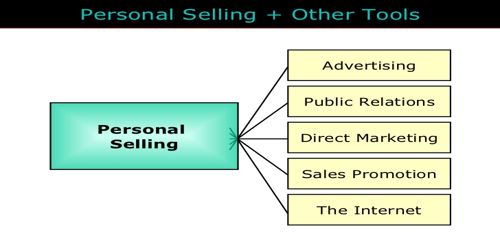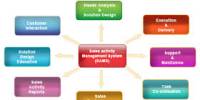Personal selling is face-to-face selling in which a seller attempts to persuade a buyer to make a purchase. It occurs where an individual salesperson sells a product, service or solution to a client. Salespeople match the benefits of their offering to the specific needs of a client. Today, personal selling involves the development of longstanding client relationships. Personal selling is one part of a company’s promotion mix, along with advertising, sales promotion, and public relations. Advertising is any form of paid sales presentation that is not done face-to-face. Television and radio commercials, newspaper and magazine advertisements, and direct mail inserts are well-known forms of advertising.
Example:
The sellers promote the product through their attitude, appearance and specialist product knowledge. They aim to inform and encourage the customer to buy, or at least trial the product.
A good example of personal selling is found in department stores on the perfume and cosmetic counters. A customer can get advice on how to apply the product and can try different products. Products with relatively high prices, or with complex features, are often sold using personal selling. Great examples include cars, office equipment (e.g. photocopiers) and many products that are sold by businesses to other industrial customers.
Sales promotion is the use of incentives—such as coupons, discounts, rebates, contests, or special displays—to entice a customer to buy a product or service. Public relations is the act of building up a company’s image in the eyes of the community in the hopes of translating the feelings of goodwill into sales. An example of public relations might include a company sponsoring a charity event.

Important stages in personal selling process
The personal selling process consists of a series of steps. Each stage of the process should be undertaken by the salesperson with utmost care. The stages in personal selling are briefly explained below.
Prospecting and qualifying: ‘Prospecting and qualifying’ are the first steps the personal selling process. This is to identify and qualify prospects in order to help sales people in the process of selling.
Pre-approach: Having found out the prospective customers, the salesperson should collect some important details about the prospects. For example, if the prospect is a company, then he should know what the company needs, who takes purchase decisions and who are its buyers.
Approach: The salesperson should properly approach the prospects. He should know how to greet the buyer before starting his conversation. The salesperson should be properly dressed which coincides with the temperament of the buyer.
Presentation and demonstration: The sales presentation should be based on AIDA formula.In other words, the presentation should gain attention, ho!d interest, arouse desire and obtain the action of the buyer.
Overcoming objections: Customers when pressed for orders, voice their objections known as customer’s resistance. The resistance of the customers may either be psychological or logical.
Closing the sale: A goods sales talk results in clinching a sale. At this juncture, the salesperson closes the sale at the right moment. A salesperson can successfully close the sale by studying the body language and the statements made by the buyers.
Follow-up and maintenance: Immediately after closing the sale, the salesperson should take some follow up measures. He may give details about delivery time, purchase terms and mode of payment of price, etc.

Advantages and disadvantages of Personal selling
The strength of personal selling is measured in terms of the merits to its credit as a distinct form of promotion. These are:
Flexibility and adaptability: Personal selling by its very nature is capable of providing more flexibility, being adaptable.
Minimum waste: The efforts put in by the salesman are highly focused on a single customer or a small group of customers. The message is likely to reach them without distortion and diffusion.
Acts as a feed-back: The salesman is, in effect, a researcher. Being in direct contact with the consumers, he has the advantage of collecting and transmitting the relevant market information affecting his company.
Creates lasting impression: The personal selling process is so direct and penetrating that lasting business relation can be developed between the selling house and the clientele.
Pulls through logical sequence: The personal selling follows a logical selling process which matches to the reasoning of one and all.
Further, he detects loss of consumer attention and interest and brings the consumer back to the track by repetitions and reinforcements.
Limitations:
However, all is not well with process of personal selling. There are certain limitations which one should take into account before giving the conclusion as to its real worth.
These limits are:
It is expensive: Personal selling as a method of promotion is quite expensive. Getting salesman is one thing and retaining him for long is another.
Difficulty of getting right kind of salesmen: Though, theoretically certain guidelines are prescribed for getting right kind of salesmen from the potential candidates, it is really very difficult to get suitable salesmen from company’s point of view.
Stake in consumer loyalty: Personal selling is such a process-direct and close between the customer and salesman that the consumer loyalty depends on the presence of such a salesman.
More administrative problems: Personal selling involves more of administrative problems than impersonal selling.
Information Source:
















